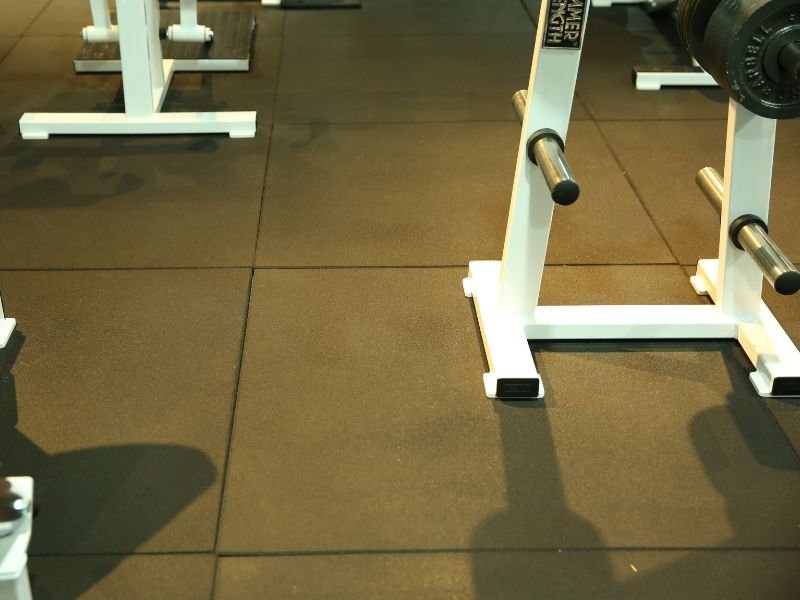High Impact Rubber Flooring Buying Guide
Looking for the right flooring for heavy weights and intense training? Choosing wrong can cost you injuries, noise complaints, and expensive replacements.
High-impact rubber flooring should be thick, shock-absorbing, slip-resistant, and durable—ideally 15–50mm tiles made from SBR or EPDM for safety and long-term performance.
 A gym isn’t just made with machines. The floor beneath them is what really takes the hit. If you’re designing a weightlifting zone or HIIT studio, you’ll want flooring that protects both people and your foundation. Here’s my no-nonsense guide to buying the right high-impact rubber floor. Visit Lanhefloor’s homepage for more flooring solutions.
A gym isn’t just made with machines. The floor beneath them is what really takes the hit. If you’re designing a weightlifting zone or HIIT studio, you’ll want flooring that protects both people and your foundation. Here’s my no-nonsense guide to buying the right high-impact rubber floor. Visit Lanhefloor’s homepage for more flooring solutions.
What makes rubber flooring “high-impact”?
High-impact rubber flooring is made to handle dropped weights, jumping workouts, and equipment vibration—without cracking, sliding, or wearing out.
| Feature | Why It Matters |
|---|---|
| Shock Absorption | Reduces injury risk & protects concrete subfloor |
| Durability | Handles thousands of barbell drops without damage |
| Slip Resistance | Prevents injury during explosive movement |
| Noise Reduction | Dampens sound in shared or urban facilities |
| Thickness | Thicker = better impact protection (20–50mm ideal) |
| Certifications | Look for EN1177, CE for safety and quality assurance |
Which high-impact flooring options does Lanhefloor offer?
The best high-impact rubber flooring from Lanhefloor includes tiny granule tiles, composite tiles, and interlocking tiles—with thickness from 15mm to 50mm.
| Product | Structure | Thickness | Installation | Ideal Area |
|---|---|---|---|---|
| Tiny Granule Rubber Tile | 100% fine SBR granules | 15–50mm | Glue-down | Weightlifting & CrossFit |
| Composite Rubber Tile | SBR + laminated EPDM surface | 15–50mm | Glue-down | Premium strength zones |
| Puzzle Interlocking Tile | SBR or EPDM with lock edges | 10–25mm | No glue needed | PT studios & modular setups |
How thick should your flooring be?
For heavy lifting, 20–50mm thick tiles are recommended. For mixed-use or light impact, 15–20mm may be enough.
| Training Type | Suggested Thickness |
|---|---|
| Olympic lifting | 30–50mm |
| CrossFit / HIIT | 20–30mm |
| Home or light studio | 15–25mm |
| Free weight zone | 20–50mm |
How to install high-impact rubber flooring?
Glue-down is best for permanent weight areas. Interlocking options are great for modular or temporary zones.
| Method | Best For | Product Fit |
|---|---|---|
| Glue-Down | Permanent gyms, barbell zones | Tiny Granule / Composite Tiles |
| Modular (Interlock) | Home setups, PT studios, rentals | Puzzle Interlocking Rubber Tile |
What if your gym includes low-impact areas?
Rubber rolls are ideal for low-impact zones and cover large areas with minimal seams.
They’re also great for offices, locker rooms, and entry zones. Learn more on our rubber roll page.
What about outdoor training zones?
If your training space includes outdoor setups, rooftop areas, or playgrounds, use outdoor rubber flooring that can handle weather and UV.
And for creative surfaces or poured playground tracks, our EPDM granules are ideal.
Conclusion
High-impact rubber flooring isn’t just a background detail—it’s what protects your gym, your people, and your brand. Choose Lanhefloor for safe, certified, factory-direct solutions. Visit lanhefloor.com to explore all our gym flooring options.
